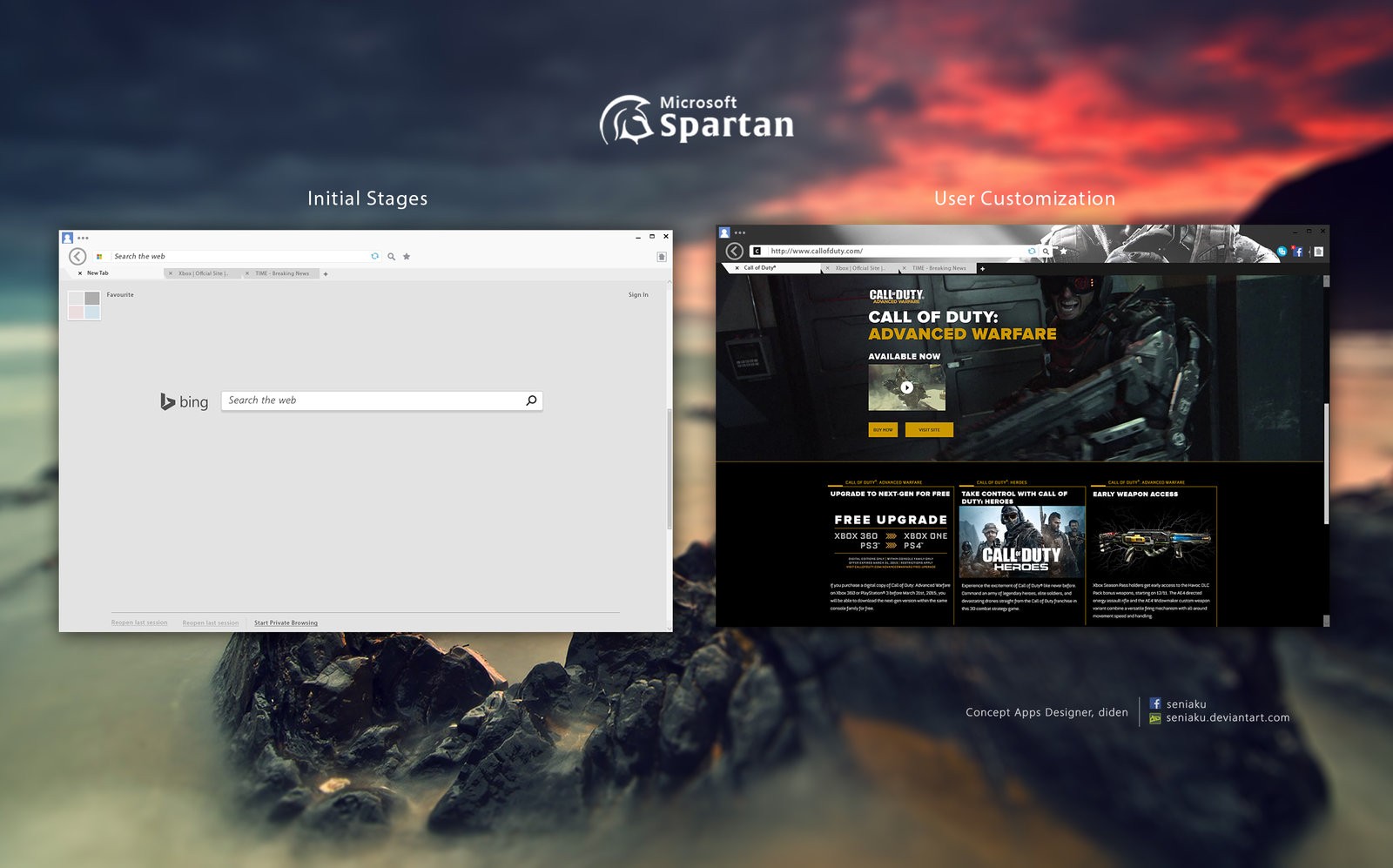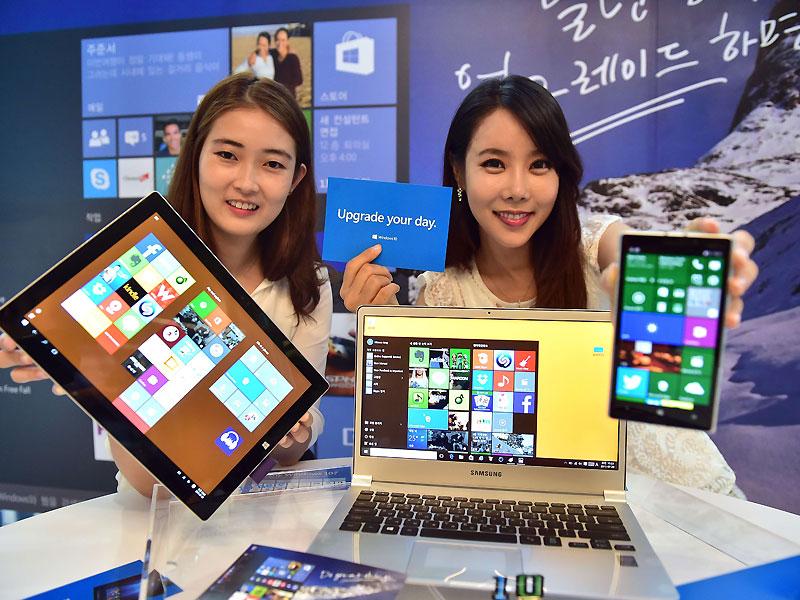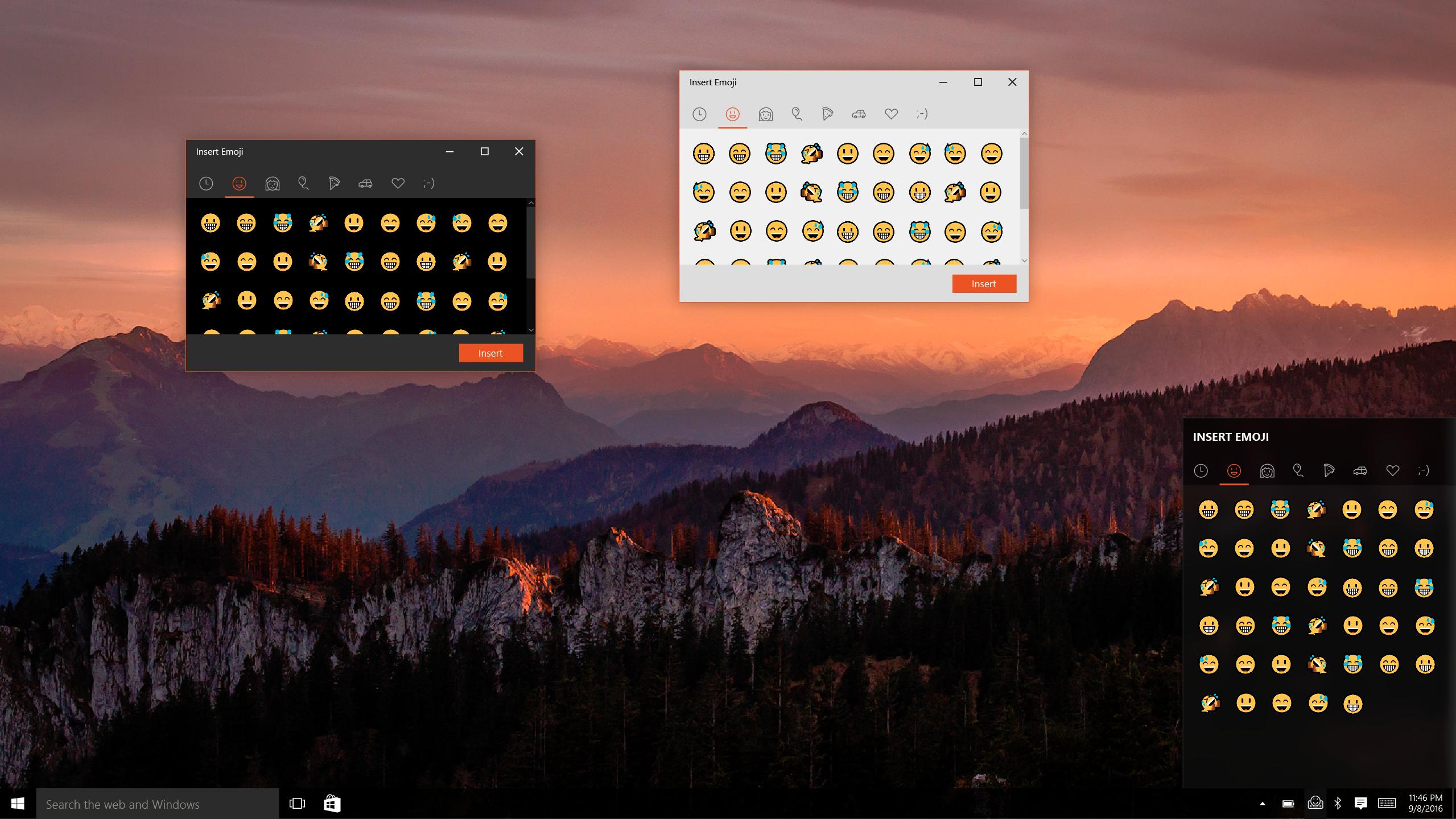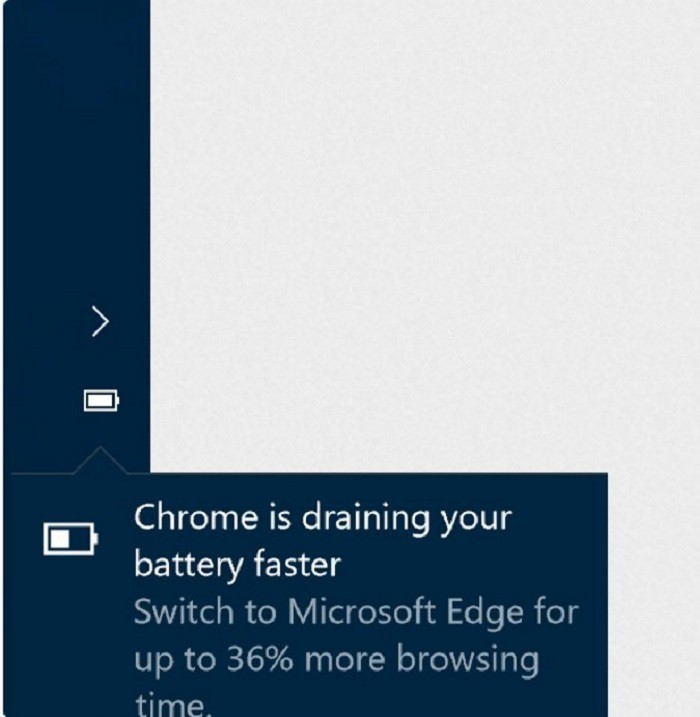On May 2, 2017, Microsoft unveiled Windows 10 S , a feature-limited edition of Windows 10 which was designed primarily for devices in the education market , such as the Surface Laptop that Microsoft also unveiled at this time. The OS restricts software installation to applications obtained from Microsoft Store; the device may be upgraded to Windows 10 Pro for a fee to enable unrestricted software installation. As a time-limited promotion, Microsoft stated that this upgrade would be free on the Surface Laptop until March 31, 2018. Windows 10 S also contains a faster initial setup and login process, and allows devices to be provisioned using a USB drive with the Windows Intune for Education platform. Windows 10 received generally positive reviews upon its original release. There are Windows 10 and Chrome OS laptops with touch screens, and both benefit greatly from them, in differing ways.
Windows 10 has tablet mode, which removes your taskbar icons and puts all apps in full-screen mode, leaving you with a minimalist workspace that removes a lot of desktop distractions. And with the new universal apps in the Windows app store, you'll be able to run most of your favorite programs in both desktop and tablet modes. Windows 10S allows users to experience a faster and more secure version of Windows, but this includes limitations.
While using Windows 10S, users can only install and use applications that are downloaded through the Microsoft Store. Additionally, Microsoft Edge is always set as the default browser, though other browsers are available for download through the Microsoft Store. While Microsoft recommends that users still use a security program while running in Windows 10S, the only compatible security program is Windows Defender Security Center. Many additional pieces of hardware, including printers, mice, and keyboards, work with Windows 10S, but some are incompatible with the system.
Windows 10S is available for Windows Enterprise and Windows Education mode. The upgrade offer was marketed and initiated using the "Get Windows 10" application, which was first downloaded and installed via Windows Update in March 2015. Registry keys and group policies could be used to partially disable the GWX mechanism, but the installation of patches to the GWX software via Windows Update could reset these keys back to defaults, and thus reactivate the software. Third-party programs were also created to assist users in applying measures to disable GWX.
This edition is designed for "special-purpose devices" that perform a fixed function . For this reason, it excludes Cortana, Microsoft Store, and all bundled Universal Windows Platform apps . A new iteration of the Start menu is used on the Windows 10 desktop, with a list of places and other options on the left side, and tiles representing applications on the right. The menu can be resized, and expanded into a full-screen display, which is the default option in Tablet mode. A new virtual desktop system was added by a feature known as Task View, which displays all open windows and allows users to switch between them, or switch between multiple workspaces.
Universal apps, which previously could be used only in full screen mode, can now be used in self-contained windows similarly to other programs. Program windows can now be snapped to quadrants of the screen by dragging them to the corner. When a window is snapped to one side of the screen, Task View appears and the user is prompted to choose a second window to fill the unused side of the screen (called "Snap Assist").
What Does Windows 11 Do Better Than Windows 10 The new Start menu takes after Windows 7's design by using only a portion of the screen and including a Windows 7-style application listing in the first column. Myerson said that these changes would occur in a future update, but did not elaborate. Windows Phone 8.1 would share nearly 90% of the common Windows Runtime APIs with Windows 8.1 on PCs. Our mission with Windows is to build a platform that inspires creativity in each of us. With Windows, not only do we want to build a platform that inspires creativity in each of us – we also want customers to have choice around the best Windows for their needs. Back in May, we introduced a new set of educational products and services, including the introduction of Windows 10 S.
Windows 10 S is the next step of our Windows journey by offering customers a familiar Windows 10 experience, streamlined for security and performance. In March 2016, some users also alleged that their Windows 7 and 8.1 devices had automatically begun upgrading to Windows 10 without their consent. In June 2016, the GWX dialog's behavior changed to make closing the window imply a consent to a scheduled upgrade. It was concluded that these users may have unknowingly clicked the "Accept" prompt without full knowledge that this would begin the upgrade. Extended support until January 13, 2032The original release of Windows 10 receives mainstream support for five years after its original release, followed by five years of extended support, but this is subject to conditions.
Microsoft stated that these devices would no longer receive feature updates, but would still receive security updates through January 2023. Microsoft will continue to support at least one standard Windows 10 release until October 14, 2025. Device Guard is designed to protect against zero-day exploits, and runs inside a hypervisor so that its operation remains separated from the operating system itself. Instead of Group Policy, it's managed the way smartphones and tablets are, using MDM tools and cloud identities. Other critics argued that Microsoft should not have triggered any downloading of Windows 10 installation files without user consent. Both the Windows versions come with support for Microsoft Passport, device encryption, side-loading of business apps, and mobile device management.
Along with that, both versions can be easily upgraded to Windows 10 Education Edition. Microsoft has said the new OS will include performance improvements, including faster logins with Windows Hello, faster web browsing and faster wake from sleep mode. Windows Hello is a biometrics-based technology that lets Windows 10 users authenticate secure access to their devices, apps and networks with iris scans, facial recognition or fingerprints.
Without doubt, Windows 8's initial insistence on imposing the tiled Start screen on devices that didn't even have a touchscreen ruined any chance of the operating system ever getting widespread business adoption. Windows 10 in S mode is a specific configuration of Windows 10 Pro designed for added security and performance. Windows 10 in S mode uses Microsoft Edge as its browser and uses apps from the Windows Store only to enhance performance and security. Some accessories and apps compatible with Windows 10 might not work , and performance might vary, even if you switch to Windows 10 Pro configuration .
For more information, go to Microsoft webpage Windows 10 in S Mode FAQ . Mac users have had one for several years, and it offers the advantages of automatic updating and a single source for finding programs you need. Acceptance to the Windows Store also means an app has been vetted by Microsoft for security. You can even install apps to external memory—something tablet users can appreciate. 10 heavily emphasizes freemium services, and contains various advertising facilities.
Some outlets have considered these to be a hidden "cost" of the free upgrade offer. Feature updates prior to version 1909 are distributed solely as an in-place upgrade installation, requiring the download of a complete operating system package (approximately 3.5 GB in size for 64-bit systems). Unlike previous builds, version 1909 is designed primarily as an update rollup version of 1903, focusing primarily on minor feature additions and enhancements. For upgrades to 1909 from 1903, a new delivery method is used where its changes were delivered as part of the monthly cumulative update, but are left in a dormant state until the 1909 update "enablement" patch is installed.
The full upgrade process is still used for those using builds prior to 1903. The Anniversary Update added Windows Subsystem for Linux , which allows the installation of a user space environment from a supported Linux distribution that runs natively on Windows. The subsystem translates Linux system calls to those of the Windows NT kernel . The environment can execute the Bash shell and 64-bit command-line programs (WSL 2 also supports 32-bit Linux programs and graphics, assuming supporting software installed, and GPUs support for other uses). Windows applications cannot be executed from the Linux environment, and vice versa. Linux distributions for Windows Subsystem for Linux are obtained through Microsoft Store.
The feature initially supported an Ubuntu-based environment; Microsoft announced in May 2017 that it would add Fedora and OpenSUSE environment options as well. Windows Update for Business will make sure that Windows 10 Pro and Enterprise users are always up to date when it comes to security features. Windows 10 Pro also supports the "Current Branch for Business" upgrade schedule, which brings Windows updates to the enterprise market after it is tested 90 days in the consumer market making sure it is sufficiently stable on release. Windows 10 S doesn't have better performance than Windows 10 out of the box. Fast-forward to a year post-installation, though, and the story might be a bit different. As most of us know, without proper maintenance, Windows slows down over time as downloaded programs fill our startup queue, registry, and services.
Windows 10 S sidesteps this issue because Windows Store apps cannot add themselves to the startup folder and so cannot begin automatically eating up your resources upon login. Thus, a year after installation, Windows 10 S should start-up just as quickly as the day it was installed. You can achieve the same thing with Windows 10 vanilla, but you can't be installing programs without maintenance. Windows 8 was arguably a failure, and we can see very few reasons why you might want to use it over Windows 10.
The start menu is far less jarring, providing modern tools and layouts sprinkled with enough familiarity that users won't feel alienated. There's a host of new security and productivity features, with more being added all the time, and the migration to Windows 10 is far smoother than anything experienced in the past. Windows 10 presents almost no learning curve for longtime Windows users, while managing to incorporate many of the advances of Windows 8—faster startup, tablet capability, better notifications, and an app store. Its windowing prowess remains unmatched, letting you easily show the desktop and snap windows to the sides and corner quadrants of the screen. Windows 10 has become the most popular operating system for desktop computers, with more than 1.3 billion active PCs running it. Despite focusing on the new Windows 11 release—now rolling out—Microsoft continues to support Windows 10 with servicing updates.
The OS continues to offer unique capabilities like touch input, a voice-based virtual assistant, face login, Windows Defender security, and mixed reality tools. Still-important but more mundane features include an improved screenshot tool, better window arrangement, and unified notifications. The OS has reached a point of polish and functionality to earn it a PCMag Editors' Choice award. As of the May 2019 update, the minimum disk space requirement has been increased to 32 GB.
In addition, on new installations, Windows permanently reserves up to 7 GB of disk space in order to ensure proper installation of future feature updates. The Windows Runtime app ecosystem was revised into the Universal Windows Platform . These universal apps are made to run across multiple platforms and device classes, including smartphones, tablets, Xbox One consoles, and other devices compatible with Windows 10. On September 30, 2014, Microsoft officially announced that Threshold would be unveiled during a media event as Windows 10. Myerson said that Windows 10 would be Microsoft's "most comprehensive platform ever", providing a single, unified platform for desktop and laptop computers, tablets, smartphones, and all-in-one devices. Despite these concessions, Myerson noted that the touch-optimized interface would evolve as well on 10.
Streamlined for security and performance, while providing a familiar Windows experience'. The way this is done is by only allowing apps found on the Microsoft Store to be installed on the device. While this can be fine if you only use Microsoft 365, Edge, and a handful of apps from the store, you'll soon run into issues if you want to use any other software. According to Microsoft the Windows 10S is streamlined for simplicity, security and speed. Windows 10S will boot 15 seconds faster than a comparable machine running Windows 10 Pro with the same profile and apps installed.
It will also receive the same updates at the same time as other versions of Windows 10. In Windows 10 S mode, you'll find the familiar Windows start menu, have Cortana as your digital assistant with speech recognition and you can download your Windows apps in the Windows Store in all versions. Digital drawing with Windows Ink and using face recognition to log in via Windows Hello is possible with 10 S, Home and Pro, provided your laptop supports this. The only web browser you can use in Windows 10 in S mode is Microsoft Edge.
The apps for Chrome and Firefox are not available in the Windows Store . Searching for things on the internet is also slightly different than you're probably used to. The default search engine in Edge's start menu or address bar is Bing.
To use Google, you have to to the Google website itself, so you have to take a small detour. Assigned Access is another Pro feature that you won't find on the Home edition. It lets you set up a kiosk computer with access to certain apps and environments only. The user cannot access anything beyond what is assigned on the PC. Basically, the user won't be able to interact with the start menu, taskbar, Windows settings, or anything that you have disabled. As familiar as Windows 11 might be, there's still a lot that's changed.
The programs you know are all still available and supported, but they'll be joined by Android apps, running as windowed programs on the desktop (though not right away — Microsoft's still fine-tuning that feature). Your favorite multitasking functions get upgraded with new Snap Layouts, and virtual desktops are getting better with more flexibility and features. Apple has posed a threat to the Windows ecosystem by introducing Mac computers that run its own Arm-based M1 chips, which boast more impressive battery life than Intel-based PCs. Microsoft and other PC makers have come out with Arm-based Windows 10 computers, but software compatibility issues have made the machines hard for reviewers to recommend. Windows 10 S gives schools the familiar, robust and productive experiences they count on from Windows –in an experience streamlined for security and superior performance in the classroom, built to work with Microsoft Education.
By exclusively using Microsoft-verified apps in the Windows Store and ensuring that you browse safely with Microsoft Edge, Windows 10 S keeps devices running fast and secure every day of the school year. There are third-party productivity options for Chrome OS, including Zoho and Polaris, but most of those programs require an internet connection as well. Google Drive, however, works offline, and we really like the real-time collaborative editing and number of useful add-ons. In the newest version of Chrome OS, the Start-like button sits in the bottom-left corner. When pressed, the launcher pop-up features a Google search bar and a list of your most recently opened apps. Depending on if your Chromebook supports Touch or not, scrolling down may Google Now info cards, which give you information like local weather, suggested articles based on your search activity, and calendar updates.
Chromebooks with support for the Play Store and Android apps have dropped the Google Now card interface. One reason for this is Continuum, which automatically adapts the Windows 10 interface to suit the mode it's being used in on hybrid devices. Microsoft has also been commendably wary of forcing businesses to install the same rolling updates to Windows 10 that are now mandatory for consumers, who can no longer opt out of Windows Updates.
Windows 10 Pro users, meanwhile, can defer updates, giving new features a few months to bed down on consumer systems before they're applied to a business machine. Windows 10S offers a secure way to avoid any potential viruses on the internet, but it also greatly limits your ability to use the internet. Many other security programs for your computer can help protect it, and there are strategies that can be used to avoid potential viruses on the internet.
In addition, this sort of security protection only protects against viruses. Many companies that have apps in the Microsoft Store may store your data or other information to the same extent as someone who was not on Windows S Mode. There is also nothing intrinsically safer about Microsoft Edge as a browser, and opening things with Firefox or Chrome will not endanger your computer. Whether you're using your voice with Cortana, gesturing on a touch screen, writing with a digital pen, building a 3D model, or playing a AAA PC game, Windows 10 offers a wealth of choices.
The platform offers the most form factors, too, from the tiny Raspberry Pi to massive gaming PCs to the large Surface Studio to the giant Surface Hub. Add to those completely new Windows devices like HoloLens and Mixed Reality headsets. Earlier Windows 10 features still deserve attention, including Clipboard History , a powerful screenshot tool, Timeline, Focus Assist, Game mode, Dark mode, Nearby Sharing, parental controls, and an updated News app. The Your Phone app syncs photos, SMS messages, and even voice calls fromAndroid phones and LTE-equipped laptops. These upgrades join Windows Hello face login and other Windows exclusives.
Even with all its forward-looking features, the OS remains familiar to longtime Windows users. For intrigued Apple users, I've compiled a list of15 Windows tips for Mac users. In October 2015, Windows 10 began to appear as an "Optional" update on the Windows Update interface, but pre-selected for installation on some systems. A Microsoft spokesperson said that this was a mistake, and that the download would no longer be pre-selected by default.
























No comments:
Post a Comment
Note: Only a member of this blog may post a comment.